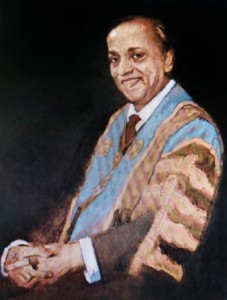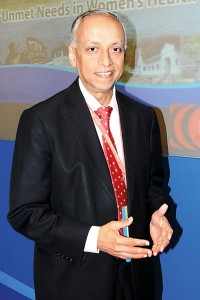Lankan Knight who saves mothers from death
Described as the “greatest living Sri Lankan” at an august international conference in Colombo recently, his credentials speak for themselves.
Saving mothers from death is his expertise, for which Professor Sir Sabaratnam Arulkumaran, 66, has been bestowed with a knighthood by Queen Elizabeth II.

In high places: The portrait of Prof. Sir Sabaratnam Arulkumaran at the Royal College of Obstetricians and Gynaecologists, London
He is President of the International Federation of Gynaecology and Obstetrics (FIGO) based in London, United Kingdom; Professor Emeritus in Obstetrics & Gynaecology, St. George’s University of London; Visiting Professor, Institute of Global Health Innovation, Imperial College; and Foundation Professor of Obstetrics and Gynaecology, St George’s Medical School, University of Nicosia.
He credits his fame in all humility to his “ability to do both research and teach” while underscoring the fact that the clinical grounding he got in Sri Lanka and research ability built up in Singapore were the tools of his success.
The journey to all these achievements which bring honour to his country of birth, Sri Lanka, began in the humble town of Nattandiya. Born in Jaffna the year, in fact just 18 days, before Ceylon emerged as an independent nation, his primary education was in Nattandiya as his father was working at the Glass Factory there. As is common with any government servant of yester-year, when his father moved, so did the family and when he joined the Marketing Department in Batticaloa as an Assistant Commissioner, young Arul followed his school career at St. Michael’s College and when his Dad moved back to Jaffna to serve on the Agrarian Service, it was to Central College and later Mahajana College in this northern town that the boy went to.
The Faculty of Medicine, University of Colombo came thereafter, with Arul graduating with his medical degree in 1972, undergoing his initial training at Ragama Hospital, then the Castle Street Hospital for Women and the Lady Ridgeway Hospital for Children. This was the time he came under the influence of Visiting Obstetrician and Gynaecologist Dr. K. Ganesan and Paediatrician Prof. Priyani Soysa while also learning the “fundamentals of obs and gyn” under Dr. Ashley Dassanayake whom he dubs “a fantastic teacher and trainer”.

In Colombo recently: Prof. Sir Sabaratnam Arulkumaran. Pic by Anuradha Bandara
A year of accident and emergency medical training followed after which it was to the United Kingdom (UK) that Dr. Arul headed for his foreign training. There was never any doubt about his specialty – obstetrics and gynaecology allowed him to practise a combination of medicine and surgery and “most of the time with a happy ending”.
On his return, keen to work in a university department but not being able to find an opening here, he had applied and secured a job in Singapore after seeing an advertisement in the British Medical Journal, leaving his homeland in March 1982. By this time he had tied the knot with Gayatri, a special education teacher.
It was a steady upward climb at the National University of Singapore for Dr. Arul, while also travelling around the globe to strengthen his research base — Lecturer, Senior Lecturer, Associate Professor and then between 1994 and 1997 Professor and Head of the Department of Obstetrics and Gynaecology.
The UK beckoned then and when Nottingham University invited Prof. Arul to found a branch Medical Faculty and reorganize the hospital in Derby, he took up the offer as his mother and younger brother were already there. After serving for four years, the University of London had requested him to apply for the Obs and Gyn Chair at St. George’s which he had done, holding the post of Professor and Head of Department from 2001 to January last year until he retired. For both these prestigious positions, he had been identified as “the man for the job” and head-hunted.
Prof. Arul is not just any doctor and teacher. He was a troubleshooter sent to help save mothers from death and he cites the example of Northwick Park Hospital where he was parachuted in to see what could be done about the 10 maternal deaths in three years.
Being recognized for the good work that he was performing, the laurels came quickly – he stepped into the international arena through FIGO, becoming its Secretary-General from 2003-06; Vice President (VP) of the Royal College of Obstetricians and Gynaecologists (RCOG) from 2005-07 and then President from 2007-10; with the knighthood being bestowed for ‘service to medicine and health’ in 2009. He also became the Secretary of the Academy of Royal Medical Colleges in 2011 and 2012 and assumed the mantle of FIGO President in 2012.
It was in 2013-14 that Sir Sabaratnam was accorded the signal honour of being invited to steer the 152,000-member, prestigious British Medical Association as its President.
The quest to save women’s lives is obvious when Sir Sabaratnam talks with passion of the need for water-tight systems and standards to be in place in obstetric and gynaecological settings.
Every hospital in the UK has a ‘Maternity Dashboard’ introduced by the RCOG under his guidance, he explains, with colour-codes of red, green and amber, which indicate when a mother is in trouble. “This became a popular tool and the government acknowledged how effective it was.”
Although this is what ensured the knighthood for Sir Sabaratnam it had not been without its initial controversies – for one crucial condition was that when a mother is bleeding the specialist should be by her bedside. “This was not popular,” he recalls, adding that the thinking has now changed and led to the strengthening of mother and child health.
Gentle and cultured is Sir Sabaratnam, but taking unpopular decisions and seeing to their implementation, for the greater good of mothers, which are the hallmarks of a strong leader are amply manifest in him.
| Good work, says Sir Sabaratnam Commending Sri Lanka for its low Maternal Mortality Rate (37 per 100,000), Sir Sabaratnam urges the professionals and government to work hand-in-hand to bring down the death rates in the north-east as well as the Nuwara Eliya district. He also explains that studies have indicated that the provision of contraception for women between 15 and 45 years helps reduce maternal mortality by around 30% and safe abortions by around 12-15%. |


